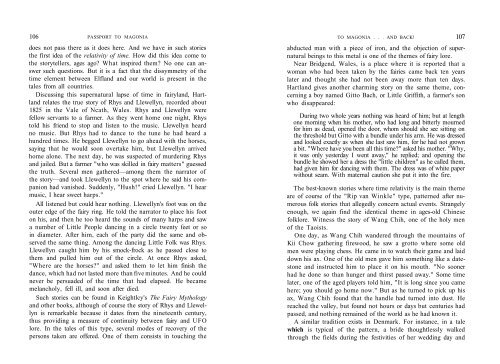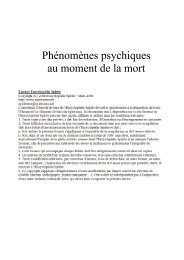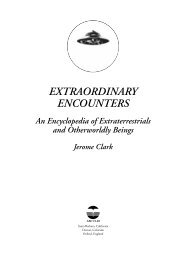Create successful ePaper yourself
Turn your PDF publications into a flip-book with our unique Google optimized e-Paper software.
106 PASSPORT TO MAGONIA<br />
does not pass there as it does here. And we have in such stories<br />
the first idea of the relativity of time. How did this idea come to<br />
the storytellers, ages ago? What inspired them? No one can answer<br />
such questions. But it is a fact that the dissymmetry of the<br />
time element between Elfland and our world is present in the<br />
tales from all countries.<br />
Discussing this supernatural lapse of time in fairyland, Hartland<br />
relates the true story of Rhys and Llewellyn, recorded about<br />
1825 in the Vale of Ncath, Wales. Rhys and Llewellyn were<br />
fellow servants to a farmer. As they went home one night, Rhys<br />
told his friend to stop and listen to the music. Llewellyn heard<br />
no music. But Rhys had to dance to the tune he had heard a<br />
hundred times. He begged Llewellyn to go ahead with the horses,<br />
saying that he would soon overtake him, but Llewellyn arrived<br />
home alone. The next day, he was suspected of murdering Rhys<br />
and jailed. But a farmer "who was skilled in fairy matters" guessed<br />
the truth. Several men gathered—among them the narrator of<br />
the story—and took Llewellyn to the spot where he said his companion<br />
had vanished. Suddenly, "Hush!" cried Llewellyn. "I hear<br />
music, I hear sweet harps."<br />
All listened but could hear nothing. Llewellyn's foot was on the<br />
outer edge of the fairy ring. He told the narrator to place his foot<br />
on his, and then he too heard the sounds of many harps and saw<br />
a number of Little People dancing in a circle twenty feet or so<br />
in diameter. After him, each of the party did the same and observed<br />
the same thing. Among the dancing Little Folk was Rhys.<br />
Llewellyn caught him by his smock-frock as he passed close to<br />
them and pulled him out of the circle. At once Rhys asked,<br />
"Where are the horses?" and asked them to let him finish the<br />
dance, which had not lasted more than five minutes. And he could<br />
never be persuaded of the time that had elapsed. He became<br />
melancholy, fell ill, and soon after died.<br />
Such stories can be found in Keightlcy's The Fairy Mythology<br />
and other books, although of course the story of Rhys and Llewellyn<br />
is remarkable because it dates from the nineteenth century,<br />
thus providing a measure of continuity between fairy and UFO<br />
lore. In the tales of this type, several modes of recovery of the<br />
persons taken are offered. One of them consists in touching the<br />
TO MAGONIA . . . AND BACK! 107<br />
abducted man with a piece of iron, and the objection of supernatural<br />
beings to this metal is one of the themes of fairy lore.<br />
Near Bridgcnd, Wales, is a place where it is reported that a<br />
woman who had been taken by the fairies came back ten years<br />
later and thought she had not been away more than ten days.<br />
Hartland gives another charming story on the same theme, concerning<br />
a boy named Gitto Bach, or Little Griffith, a farmer's son<br />
who disappeared:<br />
During two whole years nothing was heard of him; but at length<br />
one morning when his mother, who had long and bitterly mourned<br />
for him as dead, opened the door, whom should she see sitting on<br />
the threshold but Gitto with a bundle under his arm. He was dressed<br />
and looked exactly as when she last saw him, for he had not grown<br />
a bit. "Where have you been all this time?" asked his mother. "Why,<br />
it was only yesterday I went away," he replied; and opening the<br />
bundle he showed her a dress the "little children" as he called them,<br />
had given him for dancing with them. The dress was of white paper<br />
without seam. With maternal caution she put it into the fire.<br />
The best-known stories where time relativity is the main theme<br />
are of course of the "Rip van Winkle" type, patterned after numerous<br />
folk stories that allegedly concern actual events. Strangely<br />
enough, we again find the identical theme in ages-old Chinese<br />
folklore. Witness the story of Wang Chih, one of the holy men<br />
of the Taoists.<br />
One day, as Wang Chih wandered through the mountains of<br />
Kii Chow gathering firewood, he saw a grotto where some old<br />
men were playing chess. He came in to watch their game and laid<br />
down his ax. One of the old men gave him something like a datestone<br />
and instructed him to place it on his mouth. "No sooner<br />
had he done so than hunger and thirst passed away." Some time<br />
later, one of the aged players told him, "It is long since you came<br />
here; you should go home now." But as he turned to pick up his<br />
ax, Wang Chih found that the handle had turned into dust. He<br />
reached the valley, but found not hours or days but centuries had<br />
passed, and nothing remained of the world as he had known it.<br />
A similar tradition exists in Denmark. For instance, in a tale<br />
which is typical of the pattern, a bride thoughtlessly walked<br />
through the fields during the festivities of her wedding day and





